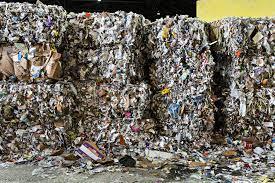What Happens to My Recyclables

Vermont State law bans certain items and materials from disposal in the trash, requiring recycling, composting, or other safe management options. However, there is no single recycling pathway, because every material has its own story. Exactly what happens to your stuff also depends on what part of the state you live in, because every waste district and independent town makes its own decisions about how to manage materials. Always reach out to your local solid waste management entity or town for more information about specific recycling programs and resources in your community.
Blue-bin recycling, including glass bottles and jars; plastic bottles, jugs, and tubs; office paper/paper mail; cardboard; and steel and aluminum cans, goes to a Materials Recovery Facility, or MRF (rhymes with “smurf”). In Vermont, we have two large MRFs, one in Rutland and one in Williston, which handle roughly 70% of Vermont's recyclables. Other smaller MRFs manage the remainder of Vermont's blue-bin recycling. At the MRFs, machines and human workers sort and separate materials by type. After sorting, individual material types are compressed into bales, which are sold to processors. Glass is separated into piles and sometimes ground to a fine sand-like texture. Contaminated recyclables and trash items that should not have been put in the recycling bin are sent to the landfill. Generally, contamination at Vermont's MRFs is 10% or less of the material collected. That means about 90% of what is brought in for recycling goes out to be recycled.
Printable reference sheet.
Comprehensive Food Waste Website link
Benefits of keeping food waste out of the Land fill link
Universal Recycling Material Management Map drop off locations.
